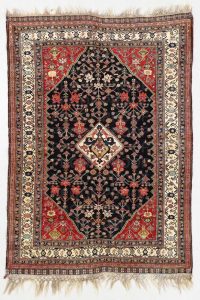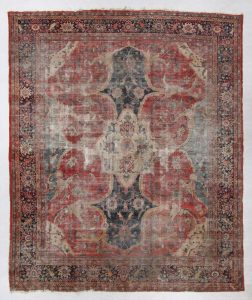Oriental Rugs from American Estates | 45
487 Lots
Live Online Auction: Wednesday, March 31, 2021, 10AM ET
Preview: March 29-30, 10am – 3pm, appointment required.
Also accepting phone and absentee bids
Browse the Auction Catalog and Bid Live on these Portals:
Absentee Bid Form | Telephone Bid Form | Terms and Conditions (PDF)
Please Note: There Are No Hidden or Confidential Reserves;
All Acceptable Bidding Commences at the Online Start Price
What’s In This Sale
This Sale, 494 lots in all, features a broad array of oriental rugs and carpets, something that will appeal to collectors on every level, and decorators with keen eyes and creative minds. Conservative estimates reflect events of a decade ago, when most antiques and collectibles, including rugs, dramatically declined in value. True enthusiasts or those who simply wish to enhance their environments still see this as a time of opportunity, when great things can be bought for inconceivably low prices, but not for much longer as values are steadily increasing, and frequently exceed low estimates.
Most of the collectible rugs in this sale are excellent examples of well known types, while others are rarely seen or offered for sale. An East Caucasian dragon sumak ( lot 92), for example, has visual appeal far beyond rug collectors, but would be a focal point of any collection of Caucasian rugs. A Kashguli “Khan” rug with silk wefts, ( lot 87) and rare to the market, is reckoned to be the best of its type. Demand for good Anatolian village rugs always exceeds availability, and the Megri (lot 79) is a sought – after example. Among the very few Tibetan “shou” rugs to have been offered for sale, lot 2 is arguably one of the best.
- Lot 92: Dragon Sumak Rug, Caucasus, Circa 1880, 7’8” x 10’7”
- Lot 87- Fine Kashguli Rug, Persia, Circa 1880, 4’0” x 5’8”
- Lot 79: Megri Rug, Turkey, 19th C., 3’11” x 6’1”
- 2: Fine Large and Rare “Shou” Rug, Tibet, Late 19th C., 5’1” x 9’7”
Caucasian rugs have an enduring appeal, and there are enough standouts in this sale to constitute a sophisticated collection in themselves, and certainly lots 77, 85, 94 and 166 would be among them. Two other Caucasian rugs are more challenging: lot 70, a very fine but very distressed Shirvan prayer rug now invites creative ways to address the missing areas, while lot 71, a Memling gul Kazak, is so beautiful as to beg to have its upper border re- woven.
- Lot 77: Kuba Rug, Caucasus, Circa 1880, 3’1” x 5’7”
- Lot 85: Fine Kuba Kilim, Caucasus, Circa 1880, 6’2” x 10’5”
- Lot 94: Eagle Kazak Rug, Caucasus, Circa 1880, 4’3” x 6’2”
- Lot 166: Kazak Rug, Caucasus, 19th C., 6’3” x 8’9”
- Lot 70: Shirvan Prayer Rug, Caucasus, 19th C., 3’10” x 5’7′
- Lot 71: Kazak Rug, Caucasus, Mid 19th C., 3’1” x 5’8”
Decorative carpets in this sale include rarely seen types, fresh to the market. A desirable Serapi (lot 84) is meticulously drawn with the “Mina Khani” design continuing from the central medallion, across the field, spandrels and borders – to great effect. Another Serapi (lot 75) is as formal as a rustic workshop could produce – a high- style folk weaving. For the big statement, it would be hard to top the twenty seven foot – long Hereke, a replica of the famous Ardabil Carpet now in the Victoria and Albert Museum.
- Lot 84: Serapi Rug, Persia, Late 19th C., 14’0” x 19’8”
- Lot 75: Fine Serapi Rug, Persia, Late 19th C., 7’10” x 10’0”
- Lot 74: Fine Agra Rug, India, 19th C., 6’1” x 7’8”
- Lot 149: Agra Rug, India, Late 19th C., 8’1” x 10’2”
There are fewer antique Indian carpets than Persian on the world market, and some connoisseurs prefer them for their formal yet serene designs and balanced palettes. Refer to lot 74, an Agra, to see a classic pairing of a cherry- red field and clear green borders. Another Agra, lot 149, is stunningly low – key, with softly colored floral – filled repeats on a honey- beige field within ivory borders.
Certain old rugs wear more gracefully than others, and there have always been a few cognoscenti who saw merit in gracefully worn rugs long before the contemporary “shabby chic” movement. A fine old Ushak, lot 91, from a Center City Philadelphia estate, invites speculation of who might have walked on it over the last century, while a stately Ziegler Sultanabad, lot 151, in the proper setting, speaks of good taste, ivy and old money. Both, of course, will pair well with antique furniture.
- Lot 91: Oushak Rug, Turkey, Late 19th C., 12’3” x 17’8”
- Lot 151: Sultanabad Rug, Persia, Late 19th C., 10’5” x 12’9” (318 x 389 cm)
- Lot 229: Sultanabad Rug, Persia, Late 19th C., 10’5” x 12’9” (318 x 389 cm)
- Lot 231: Study Group of Antique Turkmen Rugs/Fragments (11)
Perhaps of interest most to specialized scholars and collectors are lots 229, ten Anatolian fragments, and 231, eleven Turkmen fragments. Both lots would make the basis of, or addition to “study collections” that would be welcome counterparts to any dedicated library.


















